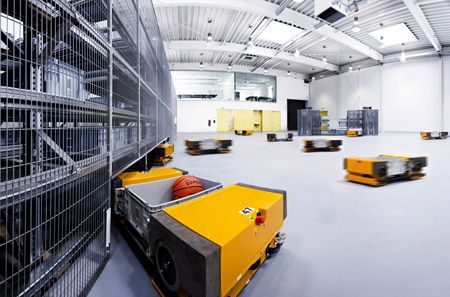Friday, 14 December 2012
The End
Wednesday, 28 March 2012
Warehouse Robots Get Smarter With Ant Intelligence

Sunday, 11 March 2012
TED talk: Robots that fly ... and cooperate by Vijay Kumar
In one of the most impressive TED talks, Professor Vijay Kumar from GRASP Lab of University of Pennsylvania explains the dynamics of flying quadcopters robots. He show some of the already viral videos produced by the lab and explains some of the math that make them possible concluding with an extraordinary musical performance! - via DIYdrones.
Friday, 23 December 2011
Swarm robotics at the Science Museum
- Short-range avoidance. If a robot gets too close to another robot or an obstacle then it turns away to avoid it.
- Longer-range attraction. If a robot can sense other robots nearby but gets too far from the flock, then it turns back toward the flock. And while in a flock, move slowly.
- If a robot loses the flock then it speeds up and wanders at random in an effort to regain the flock (i.e. another robot).
- While in a flock, each robot will communicate (via infra-red) its estimate of the position of an external light source to nearby robots in the flock. While communicating the robot flashes its green body LED.
- Also while in a flock, each robot will turn toward the 'consensus' direction of the external light source.
Tuesday, 29 November 2011
SELF-DRIVING VEHICLES SWARMING TO FUTURE ROADS
SELF-DRIVING VEHICLES SWARMING TO FUTURE ROADS
- Analysis by Nic Halverson
Schools of fish, flocks of birds -- even bicyclists in the Tour de France -- all use the principles of swarm behavior and drafting to conserve energy while moving in the same direction.
PHOTOS: Top 10 Fastest Electric Vehicles
Australian industrial designer, Charles Rattray, believes these concepts are the future of transportation. That's why he's designed Autonomo, a biomimicry inspired autonomous vehicle he hopes will revolutionize the auto industry by the year 2030.
Influenced heavily by swarm robotics and artificial intelligence, Rattray's omni-wheeled, self-driving Autonomos would travel in tight platoons while shifting their configurations to maintain an uninterrupted traffic flow. Microwave sensors would allow cars to travel a mere 7.8 inches apart, thus aerodynamically reducing vehicle drag and energy consumption, making tailgating actually a good thing.
Onboard computers would synthesize data from an array of sensors (radar, microwave, lidar, optical and infrared) and external feedback systems that would monitor the road 656 feet in front of and behind the vehicle or vehicle platoon. There's also hi-def cameras equipped with object recognition technologies that would help predict the path of other vehicles, cyclists, pedestrians and other hazardous objects.
Balancing these flocks of vehicles would be a centralized database controlled by intelligent algorithms that could adjust as new spatial information is fed to them.
Rattray's concept vehicle is a svelte 3.77 foot wide two-seater with bobsled-style seating. It's slim design would allow Autonomos to travel two abreast in a single lane so that existing road infrastructures would not need overhauling.
Vehicles would be charged wirelessly through electrodynamic induction or energy transfer lasers via charging pads embedded on the surface of the road.
BLOG: Speed Bumps You'll Be Happy To Drive Over
Obviously, this project aims to lasso the moon with an ambition of fantastical proportions. But as the great architect of Chicago, Daniel Burnham, once said, "Make no little plans. They have no magic to stir men's blood and probably themselves will not be realized."
[Via GizMag]
Credit: Charles Rattray
Friday, 25 November 2011
I, for one, welcome our new farming robots
One step closer to the robots taking over!
Wired’s Eric Smalley has an awesomely titled article about a Massachusetts based startup, Harvest Automation, is testing a small farming robot to work in nurseries in the horticulture industry.

The Harvest Automation robots are knee-high, wheeled machines. Each robot has a gripper for grasping pots, a deck for carrying pots, and an array of sensors to keep track of where it is and what’s around it. Teams of robots zip around nursery fields, single-mindedly spacing and grouping plants. Think Wall-E without the doe eyes and cuddly personality, or the little forest-tending ‘bots in the 1972 sci-fi classic Silent Running.
Thank you Wired!
Share and Enjoy:






Tuesday, 4 October 2011
EPFL Researchers Demonstrate Flocking

The above image is taken from a video of research done by Sabine Hauert, Severin Leven, and Dario Floreano of the Laboratory of Intelligent Systems, EPFL, Lausanne, Switzerland. As part of this research, they tested the effects of turning radius and communications range on programmed flocking behavior in a group of ten aerial robots. More details are available on the Wired Science blog, and in the video.






